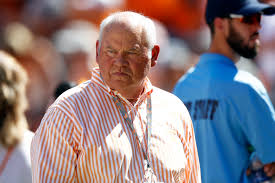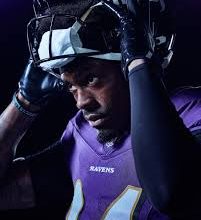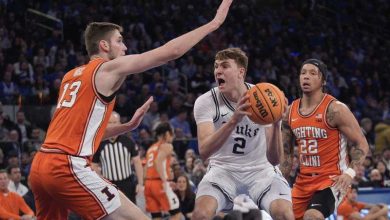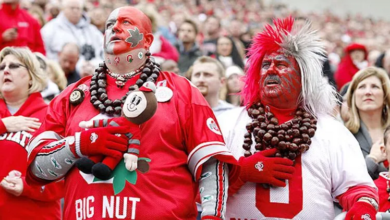Changes to the Baltimore Ravens’ offensive line are imminent.
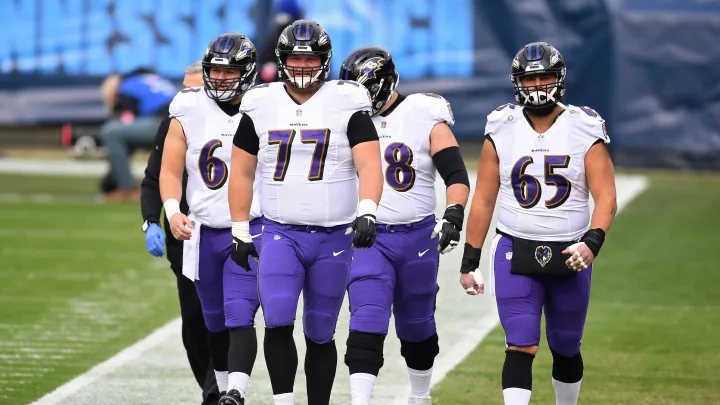
Changes to the Baltimore Ravens’ Offensive Line Are Imminent: A Crucial Transition for the Team’s Future Success
The Baltimore Ravens have been a fixture of competitiveness in the NFL for the better part of the past two decades. Their formula for success has been grounded in a dominating defense, a powerful ground game led by quarterbacks like Lamar Jackson, and a fundamentally sound offensive line. While the team has consistently been competitive, particularly under head coach John Harbaugh, changes to their offensive line are now imminent. These changes are not just necessary—they are critical for the Ravens to remain viable Super Bowl contenders and for Lamar Jackson to continue his growth as a franchise quarterback.
Over the last few seasons, the Ravens’ offensive line has been a combination of veteran presence and unproven youth, sometimes resulting in inconsistent play. While the line has occasionally performed at an elite level, there have also been stretches where it failed to protect Jackson adequately or open up running lanes with the same consistency that the Ravens’ offense requires. As the Ravens move into the next phase of their window for contention, the team must overhaul the offensive line to protect their investment in Jackson, give their rushing attack the best chance to succeed, and create a more stable platform for their passing game.
This article will explore the current state of the Ravens’ offensive line, the challenges they have faced in recent seasons, and how changes to personnel, coaching, and scheme can help the team regain its offensive line dominance. We’ll also delve into potential solutions, focusing on player acquisitions, coaching strategies, and the long-term outlook for the Ravens’ offensive line as the 2025 NFL season approaches.
Current State of the Baltimore Ravens’ Offensive Line
At its peak, the Ravens’ offensive line was one of the most dominant in the NFL. The team has historically built around a physical offensive line that could run-block with the best of them, allowing for a dominant rushing attack to complement their defense and the playmaking ability of Lamar Jackson. However, in recent seasons, the line has been a bit of a mixed bag. It has shown flashes of elite play but has also had a number of issues that have prevented it from being the elite unit that the team needs to contend for a championship.
1. Pass Protection Issues
One of the more prominent concerns surrounding the Ravens’ offensive line in recent years has been their struggles with pass protection, especially when it comes to keeping Lamar Jackson clean in the pocket. Jackson is a dynamic dual-threat quarterback who thrives when he’s allowed to extend plays, but even with his mobility, a suspect offensive line has often led to unnecessary pressure on the quarterback. In 2023, the Ravens’ offensive line allowed 40 sacks, ranking in the middle of the pack for the league. While Jackson’s ability to escape pressure has mitigated some of the damage, the overall lack of stability in pass protection has stunted the Ravens’ passing game.
In particular, the interior of the offensive line has been problematic. Bradley Bozeman, once the team’s starting center, was let go in free agency, and the Ravens have struggled to replace him with a player of his caliber. Both Ben Powers and Tyre Phillips, players who have rotated in at guard positions, have shown moments of inconsistency. When they’ve faced teams with strong pass rushers or blitz-heavy schemes, the Ravens have struggled to protect Jackson, causing havoc in the pocket.
The Ravens’ struggles in pass protection are especially concerning given that Jackson has often been asked to throw from the pocket rather than relying solely on his legs. The emergence of receivers like Rashod Bateman and Mark Andrews, as well as a more pass-friendly offense under offensive coordinator Greg Roman, has made it clear that Jackson needs more consistent protection to develop into a more well-rounded passer.
2. Run Blocking Inconsistencies
While the Ravens have maintained a dominant rushing attack, powered by Jackson and running backs like J.K. Dobbins and Gus Edwards, the offensive line’s ability to consistently open up running lanes has been inconsistent. The line has struggled with communication and cohesion at times, especially against defensive fronts that excel at clogging running lanes or stuffing the box.
The Ravens’ offensive line, traditionally known for its ability to create push in the running game, has had a number of plays where it couldn’t sustain blocks long enough for running backs to find lanes. Kevin Zeitler, the veteran right guard, has been a stable force on the line, but the other spots have had trouble establishing a consistent running game. This inconsistency in the running game has been especially noticeable in short-yardage situations, where the Ravens have struggled to generate the push necessary to get the tough yards.
For the Ravens to truly take advantage of their dynamic quarterback and talented running backs, they need a line that can consistently open lanes and create holes. This is crucial not only for the success of their rushing attack but for the overall balance of the offense.
3. Injuries and Depth Issues
Another ongoing issue for the Ravens has been injuries along the offensive line. In recent years, key players like Ronnie Stanley, the left tackle, have struggled with injuries. Stanley, considered one of the better left tackles in the NFL when healthy, has had to battle through a series of injuries, limiting his ability to stay on the field and provide stability to the offensive line. His absence has forced the Ravens to shuffle their lineup, creating inconsistency.
In 2023, the Ravens had to deal with injuries to multiple linemen, including Tyre Phillips and Alejandro Villanueva, both of whom missed time. Depth issues have forced Baltimore to plug in inexperienced players at various points, further compounding the challenges on the line.
For a team with championship aspirations, a healthy and deep offensive line is paramount. The Ravens cannot afford to have key players missing games or be forced to rely on unproven or subpar backups in critical moments.
The Imminent Changes to the Ravens’ Offensive Line
Given the issues the Ravens have encountered along the offensive line, it is clear that changes are necessary for the team to continue competing at a high level. As the team looks toward the 2025 season, a few specific areas need attention: personnel, coaching, and depth.
1. Personnel Changes and Player Acquisitions
The most immediate way the Ravens can address their offensive line issues is by making personnel changes. One obvious area of focus is upgrading the left tackle position. While Ronnie Stanley is a gifted player when healthy, his injury history has made it difficult to rely on him as the long-term anchor at that position. If Stanley’s injuries continue to be a concern, the Ravens may look to the draft or free agency to find a long-term solution at left tackle. A highly-rated left tackle from the 2025 draft class could provide the Ravens with stability at a crucial position.
Similarly, the Ravens may look to upgrade their interior offensive line. The right guard and center positions have been inconsistent, and finding a player who can come in and provide immediate stability and improvement would be beneficial. Whether through free agency or the draft, the Ravens need to address their interior line issues and bring in players who can perform at a higher level.
Lastly, depth is a major concern. Injuries have consistently ravaged the offensive line in recent years, and the Ravens need to bolster their depth with reliable backup players who can step in when needed without causing significant drop-offs in performance. Developing young talent through the draft or targeting affordable veteran depth players in free agency could be part of the Ravens’ strategy moving forward.
2. Coaching and Scheme Adjustments
Another crucial element in improving the Ravens’ offensive line will be adjustments to coaching and scheme. The offensive line is a position that thrives on cohesion, and coaching plays a huge role in ensuring that the linemen work together as a unit. The Ravens’ offensive line coach, Joe D’Alessandris, has a wealth of experience, but it’s possible that some fresh ideas or tweaks in approach may be necessary to adapt to the modern NFL game.
The Ravens could also tweak their offensive system to better fit the strengths of their offensive line. The heavy reliance on power running schemes, such as zone-blocking and gap-schemes, has worked well in the past, but the team may look to introduce more creative schemes to keep defenses guessing. A more balanced offense that uses play-action and quick throws could alleviate some of the pressure on the offensive line, giving them time to settle into games.
3. Investing in Long-Term Stability
Ultimately, the Ravens’ ability to build a stable offensive line goes hand-in-hand with their larger organizational goals. To be competitive in the long term, the team must prioritize drafting and developing offensive line talent, not just for the immediate future, but as a long-term solution. By selecting high-value offensive line prospects and allowing them to develop within the system, the Ravens can ensure they won’t have to make drastic changes every few seasons.



